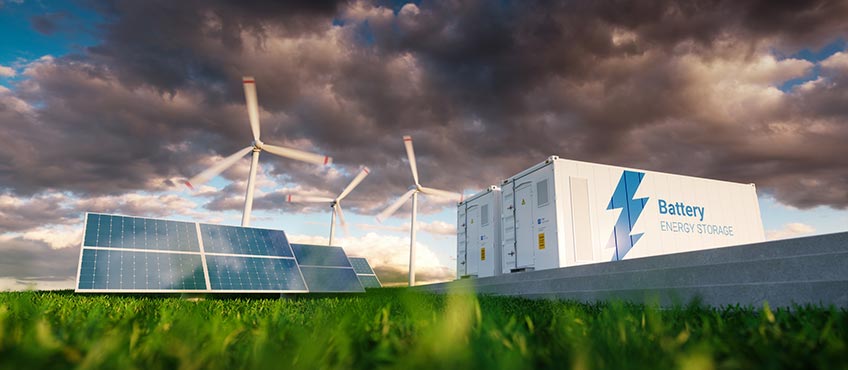Utility-Scale Energy Storage
Utility-scale energy storage involves large-scale storage systems that capture energy produced from renewable sources like solar and wind, and store it for use when production is low. This technology is crucial for stabilizing the grid, reducing reliance on fossil fuels, and mitigating climate change.

Solar PV and Wind energy Storage (NREL)
View open jobs in this Solution
Example Companies
- H2 - H2 is a Korea-based advanced energy storage company specialized in vanadium redox flow battery.
- UniEnergy Technologies - UniEnergy Technologies is a produces large-scale energy storage systems
- Rongke Power - Rongke Energy Storage is a vanadium redox flow battery energy storage system service provider.
- On.Energy - On.Energy is an energy storage developer that offers AI-powered energy management software and in-house analytics for grid-scale projects.
- Tesla - Develops large-scale battery storage systems like the Tesla Powerpack and Megapack.
- NextEra Energy - Implements utility-scale energy storage projects across the U.S.
- Fluence - Provides energy storage technology and services for utilities and commercial customers.
- AES Corporation - Develops and operates utility-scale energy storage systems.
- LG Chem - Manufactures advanced battery storage solutions for utility-scale applications.
Overview
Advancements in utility-scale energy storage are driving climate change reversal through key technologies:
- Battery Storage: Storing energy for homes, businesses, and utilities, reducing reliance on fossil fuels.
- Solar PV Storage: Capturing solar energy for use during cloudy periods, reducing fossil fuel dependency.
- Wind Energy Storage: Storing wind energy for use during calm periods, lessening fossil fuel use.
The biggest benchmark from Speed & Scale
$10 per kWh cost for long-duration electricity storage (14–30 days)
Use their news tracking tool to track progress
Progress Made
Significant progress in utility-scale energy storage includes:
- Lithium-Ion Batteries: High energy density and cost-efficient.
- Flow Batteries: Long-lasting and scalable.
- Supercapacitors: Rapid energy storage for grid stability.
Solutions by Sector
Battery Storage
- Lithium-Ion Batteries: Widely used for their high energy density and efficiency.
- Flow Batteries: Suitable for long-duration energy storage.
- Solid-State Batteries: Emerging technology with higher safety and energy density.
Case Studies:
- Tesla, USA: The Hornsdale Power Reserve in South Australia, featuring Tesla's Powerpack, is one of the largest lithium-ion battery installations in the world (Tesla).
- NextEra Energy, USA: Implements utility-scale energy storage projects across the U.S., integrating renewable energy sources (NextEra Energy).
- Fluence, Global: Provides energy storage technology and services for utilities and commercial customers, with projects like the Alamitos Energy Center in California (Fluence).
Solar PV Storage
- Solar-Plus-Storage Systems: Combining solar panels with battery storage to provide consistent energy supply.
- Microgrids: Small-scale grids that can operate independently using solar and storage.
- Virtual Power Plants: Networks of distributed energy resources managed as a single entity.
Case Studies:
- AES Corporation, USA: Develops and operates utility-scale solar-plus-storage projects, such as the Kauai Island Utility Cooperative in Hawaii (AES Corporation).
- LG Chem, South Korea: Manufactures advanced battery storage solutions for utility-scale solar projects (LG Chem).
- SunPower, USA: Provides solar energy storage systems for residential and commercial applications, integrating with utility-scale projects (SunPower).
Wind Energy Storage
- Compressed Air Energy Storage (CAES): Storing energy by compressing air in underground caverns.
- Pumped Hydro Storage: Using excess wind energy to pump water uphill, which is then released to generate electricity.
- Flywheels: Storing energy in the form of rotational kinetic energy.
Case Studies:
- Hydrostor, Canada: Develops CAES projects to store wind energy, such as the Goderich CAES facility in Ontario (Hydrostor).
- EDF Renewables, France: Implements pumped hydro storage projects to complement wind energy, such as the La Coche project in France (EDF Renewables).
- Beacon Power, USA: Uses flywheel technology to provide grid stability and store wind energy, with projects like the Stephentown Spindle in New York (Beacon Power).
Lessons Learned
Lessons from utility-scale energy storage development:
- Effective Grid Integration: Vital to prevent disruptions and ensure smooth operation.
- Clear Policies: Needed for successful deployment and regulatory compliance.
- Stakeholder Collaboration: Essential for well-informed and supported projects.
Mistakes to Avoid:
- Overlooking grid integration.
- Ignoring policy framework.
- Disregarding public input.
Challenges Ahead
Overcoming utility-scale energy storage challenges:
- Cost Efficiency: Key for competitiveness and widespread adoption.
- Enhanced Efficiency: Developing technologies that store more energy per unit.
- Durability Improvement: Extending the lifespan of storage systems.
Best Path Forward
Future of utility-scale energy storage:
- Continued R&D Investment: Support ongoing research and development to improve storage technologies.
- Partnership with Utilities: Collaborate with utility companies to integrate storage solutions into the grid.
- Policy Support: Advocate for policies that incentivize the deployment of energy storage systems.
- Public Awareness: Increase awareness about the benefits of energy storage for climate change mitigation.
Prominent supporters include Tesla, NextEra Energy, Fluence, AES Corporation, and LG Chem.
Image credit: NREL